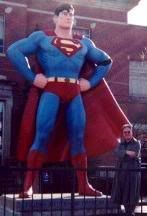| Pop Culture Gadabout | ||
|
Thursday, December 04, 2008 ( 12/04/2008 06:27:00 AM ) Bill S. "THERE ARE LOTS OF NICE PEOPLE AT THE PARTY – BUT NOT MANY." Caught an old movie curiosity, the Oliver Hardy vehicle Zenobia (1939), off the DVR recently. It's one of the few films he did solo after teaming up with Stan Laurel - in which he plays a character different from "Ollie." Hardy is Dr. Henry Tibbit, a country doctor in the small town of Casterville, Mississippi, circa 1870. Married to Billie Burke at her most blithering, Dr. T. is a kindly soul who's turned away from treating the hypochondriac dowagers in his community in favor of the less well-to-do who really need his services. This decision has led to a downturn in the family fortunes, though when the movie opens, we see he and his family reside in a nice house and still manage to maintain two servants (Hatty McDaniel and mush-mouthed Stepin Fetchit). The movie centers on the problems created after Doc Tibbit is called to to treat an ailing circus elephant named Zenobia. After "curing" her, he's pursued through town by the pachyderm, who seems to have become smitten by the rotund physician. Zenobia's owner (Harry Langdon) winds up suing the doctor for alienation of affection, and our hero is forced to defend himself in court. Intertwined in the midst of all this is a not-very-interesting thwarted romance between the doctor's daughter and the son of the aforementioned hypochondriac moneybags - who sees the doctor's family as being beneath her son. Zenobia was filmed during a period when Stan Laurel was in a contract dispute with Hal Roach Studios and was trumpeted initially as an attempt to team Oliver Hardy with a fresh partner, the baby-faced Langdon. As a team-up movie, the film doesn't really devote a lot of time to establishing Hardy/Langdon as a comic couple. It has only one decent sequence featuring the comedians really working with each other - an amusing slapstick scene where the doctor attempts to examine to examine Zenobia - while more of the film is devoted to domestic and class-based comedy featuring the doctor and his wife Bessie. We're also provided two sequences where the benevolent M.D. teaches a cute black kid (Philip Hurlic) about the Declaration of Independence. It's a fascinating reflection of the era's idea of benevolent segregation: all men are created equal, even if they can't really mingle with each other too much. ("You don't go to white folks parties," Tibbit explains to the lad. "I don't go to colored folks' parties.") Depending on your tolerance for this kind of dated material, these scenes come across as essentially good-hearted or condescending. I went for the first response, myself, though perhaps if the movie had given me too many scenes with Fetchit going through his stereotypical shtick, I wouldn't have. The film's conflicts are all resolved after the young boy Zeke recites the entire Declaration in front of everybody at the courthouse: milquetoast son stands up to his controlling mother to declare his love for the doctor's daughter; controlling mother gets Langdon's character to drop his lawsuit; happy negroes learn their son is a whiz at memorizin' stuff. All that's left to learn the real reason the lady Zenobia has been following Dr. T. all around town. You can probably guess it, though how Langdon's elephant owner would miss it is beyond me. I'm told that elephants have a long gestation period, though. It's a decent little movie artifact, though nowhere near as funny as the best Stan and Ollie shorts or features (Sons of the Desert, say). Hardy shows clear range as a comic actor (still does a couple of his patented frustrated looks into the camera, though), playing a less cartoonish, more recognizably grown-up character. The man had the capacity to be a strong comic character actor on his own, though, happily, he was soon back in front of the cameras with Stanley. Labels: obscuro comedies # | |
|
|

